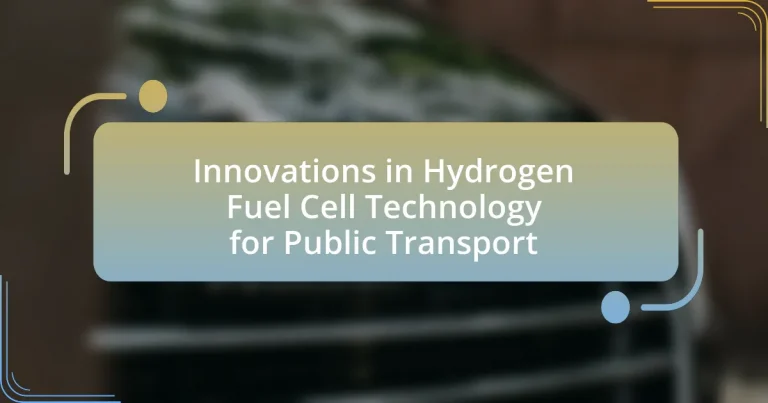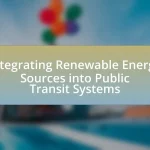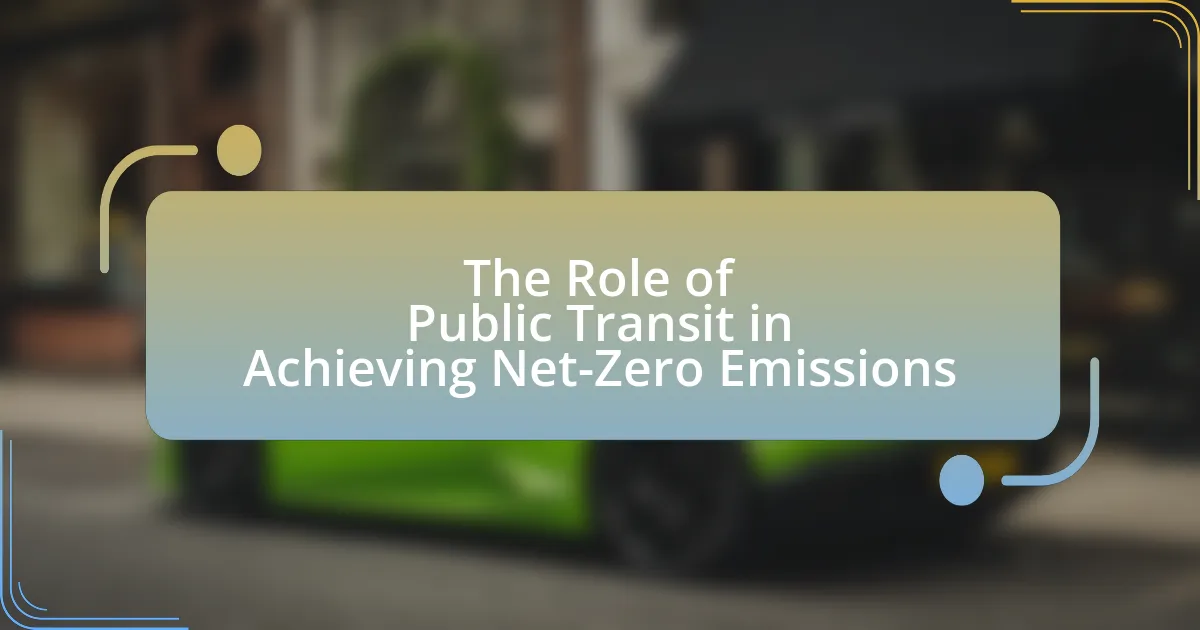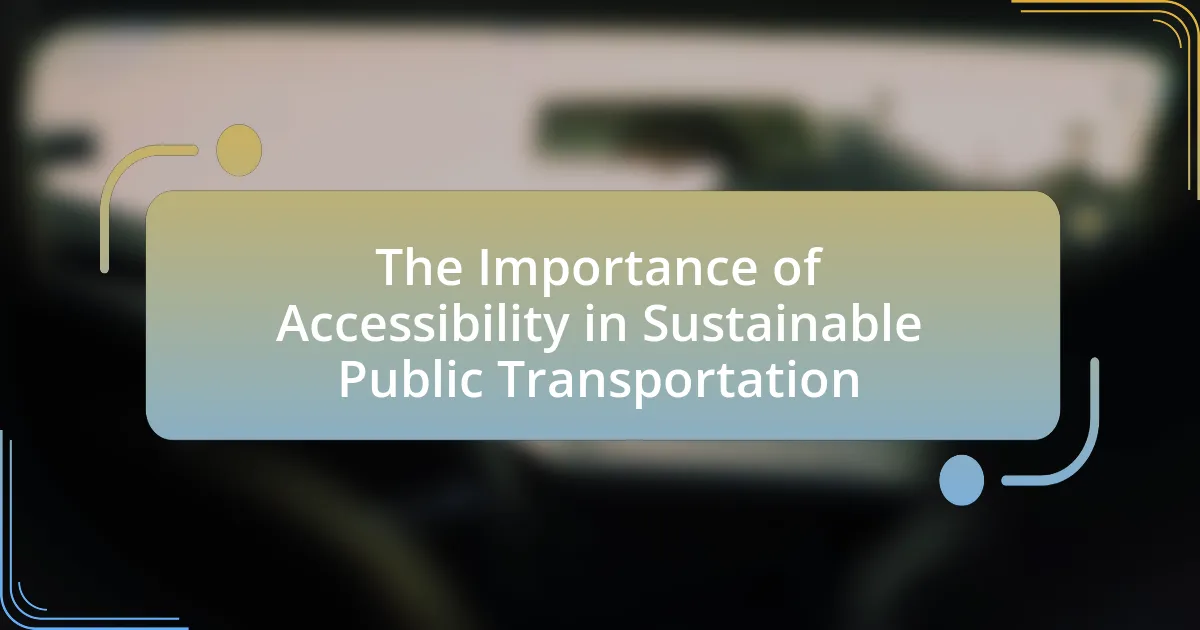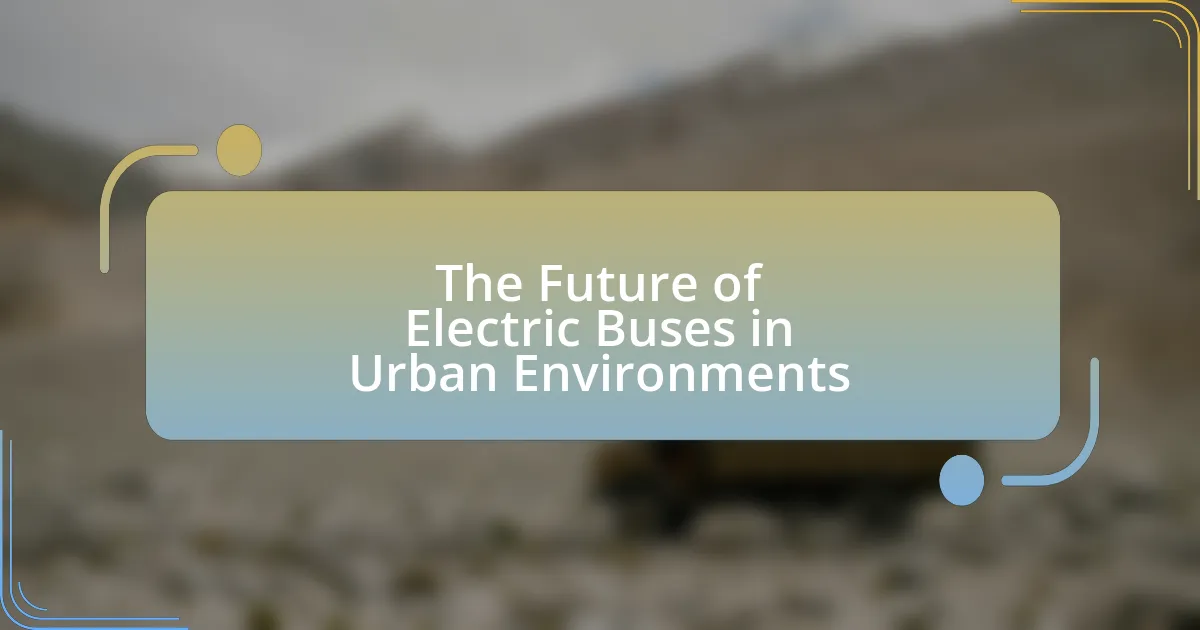Innovations in hydrogen fuel cell technology are transforming public transport by enhancing fuel cell efficiency, utilizing lightweight materials, and implementing integrated energy management systems. Recent advancements have achieved over 60% efficiency in fuel cells, improving the performance and range of hydrogen-powered buses and trains while significantly reducing greenhouse gas emissions. Key components of hydrogen fuel cells, such as the anode, cathode, and electrolyte membrane, facilitate the conversion of hydrogen into electricity, emitting only water vapor as a byproduct. Despite challenges related to infrastructure and costs, ongoing research and investment from major automotive companies are driving the adoption of hydrogen fuel cells in urban mobility, promoting a cleaner and more sustainable public transport system.
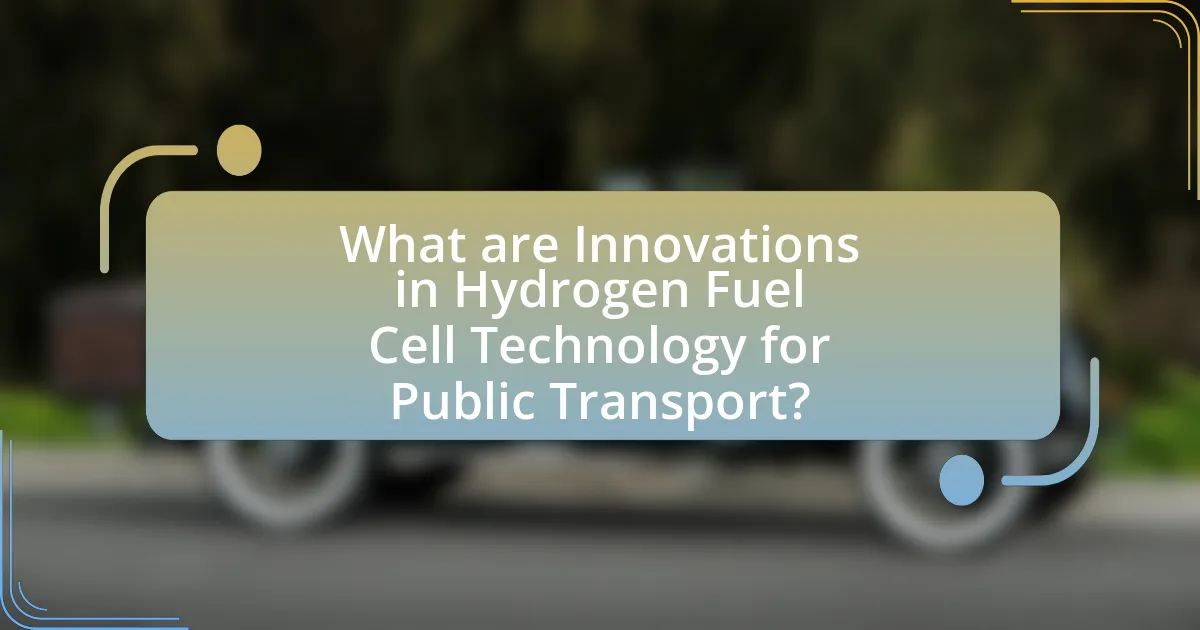
What are Innovations in Hydrogen Fuel Cell Technology for Public Transport?
Innovations in hydrogen fuel cell technology for public transport include advancements in fuel cell efficiency, lightweight materials, and integrated systems for better energy management. Recent developments have led to fuel cells achieving over 60% efficiency, significantly improving the range and performance of hydrogen-powered buses and trains. Additionally, the use of composite materials has reduced vehicle weight, enhancing fuel economy. Furthermore, integrated energy management systems optimize the use of hydrogen and electricity, allowing for smoother operation and reduced emissions. These innovations are supported by ongoing research and investment from companies like Toyota and Hyundai, which are actively deploying hydrogen fuel cell vehicles in public transport systems worldwide.
How do hydrogen fuel cells function in public transport systems?
Hydrogen fuel cells function in public transport systems by converting hydrogen gas into electricity through an electrochemical reaction, which powers electric motors. This process involves hydrogen entering the fuel cell, where it reacts with oxygen from the air, producing electricity, water, and heat as byproducts. The electricity generated is used to drive electric buses or trains, providing a clean and efficient alternative to traditional fossil fuel-powered vehicles. According to the U.S. Department of Energy, hydrogen fuel cell vehicles emit only water vapor, significantly reducing greenhouse gas emissions compared to conventional transport options.
What are the key components of hydrogen fuel cells used in public transport?
The key components of hydrogen fuel cells used in public transport are the anode, cathode, electrolyte membrane, hydrogen supply system, and power management system. The anode facilitates the oxidation of hydrogen, while the cathode allows for the reduction of oxygen. The electrolyte membrane, typically made of a proton exchange membrane, conducts protons from the anode to the cathode while being impermeable to gases. The hydrogen supply system stores and delivers hydrogen gas to the anode, and the power management system regulates the electrical output for vehicle operation. These components work together to convert chemical energy from hydrogen into electrical energy, enabling efficient and clean public transportation solutions.
How does the energy conversion process work in hydrogen fuel cells?
Hydrogen fuel cells convert chemical energy from hydrogen into electrical energy through an electrochemical reaction. In this process, hydrogen gas enters the fuel cell at the anode, where it is split into protons and electrons. The protons pass through a proton exchange membrane to the cathode, while the electrons travel through an external circuit, generating electricity. At the cathode, oxygen from the air combines with the protons and electrons to produce water and heat as byproducts. This efficient conversion process allows hydrogen fuel cells to provide clean energy for public transport applications, significantly reducing greenhouse gas emissions compared to traditional fossil fuels.
What advancements have been made in hydrogen fuel cell technology?
Recent advancements in hydrogen fuel cell technology include increased efficiency, reduced costs, and enhanced durability. For instance, researchers have developed advanced membrane materials that improve proton conductivity, leading to higher energy output and efficiency rates exceeding 60%. Additionally, the cost of producing hydrogen fuel cells has decreased significantly, with estimates showing a reduction of over 50% in the last decade due to economies of scale and improved manufacturing processes. Furthermore, durability has been enhanced through innovations in catalyst design, allowing fuel cells to operate effectively for over 5,000 hours, which is a substantial improvement compared to earlier models. These advancements collectively support the growing adoption of hydrogen fuel cells in public transport systems, making them a viable alternative to traditional fossil fuels.
What are the latest breakthroughs in fuel cell efficiency?
Recent breakthroughs in fuel cell efficiency include the development of advanced catalysts that significantly reduce the amount of precious metals required, enhancing overall performance and cost-effectiveness. For instance, researchers at the University of California, Berkeley, have created a new catalyst using nickel and iron that achieves over 90% efficiency in converting hydrogen to electricity, compared to traditional platinum-based catalysts. This innovation not only lowers material costs but also improves the durability and longevity of fuel cells, making them more viable for public transport applications. Additionally, advancements in membrane technology, such as the use of proton exchange membranes that operate at higher temperatures, have been shown to increase efficiency by allowing for faster reaction rates and improved water management within the fuel cell system.
How have materials science innovations impacted fuel cell performance?
Materials science innovations have significantly enhanced fuel cell performance by improving the efficiency and durability of components. For instance, advancements in catalyst materials, such as the development of platinum alloys and non-precious metal catalysts, have led to increased reaction rates and reduced costs, enhancing overall energy conversion efficiency. Additionally, innovations in membrane technology, including the use of proton exchange membranes with higher conductivity and lower thickness, have improved ion transport and reduced energy losses. Research indicates that these materials advancements can lead to fuel cells achieving over 60% efficiency in converting hydrogen to electricity, compared to traditional systems.
What are the environmental benefits of using hydrogen fuel cells in public transport?
Hydrogen fuel cells in public transport significantly reduce greenhouse gas emissions, primarily by emitting only water vapor as a byproduct. This transition from fossil fuel-powered vehicles to hydrogen fuel cell technology can lead to a substantial decrease in air pollutants, such as nitrogen oxides and particulate matter, which are harmful to both human health and the environment. For instance, a study by the International Energy Agency indicates that hydrogen fuel cells can reduce CO2 emissions by up to 70% compared to traditional diesel buses. Additionally, hydrogen production can be achieved through renewable energy sources, further enhancing its environmental benefits by promoting sustainable energy practices.
How do hydrogen fuel cells reduce greenhouse gas emissions?
Hydrogen fuel cells reduce greenhouse gas emissions by converting hydrogen and oxygen into electricity, with water vapor as the only byproduct. This process eliminates the combustion of fossil fuels, which is a primary source of carbon dioxide and other greenhouse gases. According to the U.S. Department of Energy, hydrogen fuel cells can achieve efficiencies of up to 60%, significantly lowering emissions compared to traditional internal combustion engines that typically operate at around 20% efficiency. Additionally, when hydrogen is produced from renewable sources, such as wind or solar energy, the overall lifecycle emissions are drastically reduced, further contributing to a decrease in greenhouse gas emissions.
What role do hydrogen fuel cells play in sustainable urban mobility?
Hydrogen fuel cells play a crucial role in sustainable urban mobility by providing a clean and efficient energy source for public transportation. These fuel cells convert hydrogen into electricity, emitting only water vapor as a byproduct, which significantly reduces greenhouse gas emissions compared to traditional fossil fuel vehicles. For instance, hydrogen fuel cell buses can operate with a range of up to 300 miles and refuel in about 15 minutes, making them a practical alternative for urban transit systems. Additionally, cities like Hamburg and London have already integrated hydrogen fuel cell buses into their fleets, demonstrating their viability and effectiveness in reducing urban air pollution and dependence on fossil fuels.
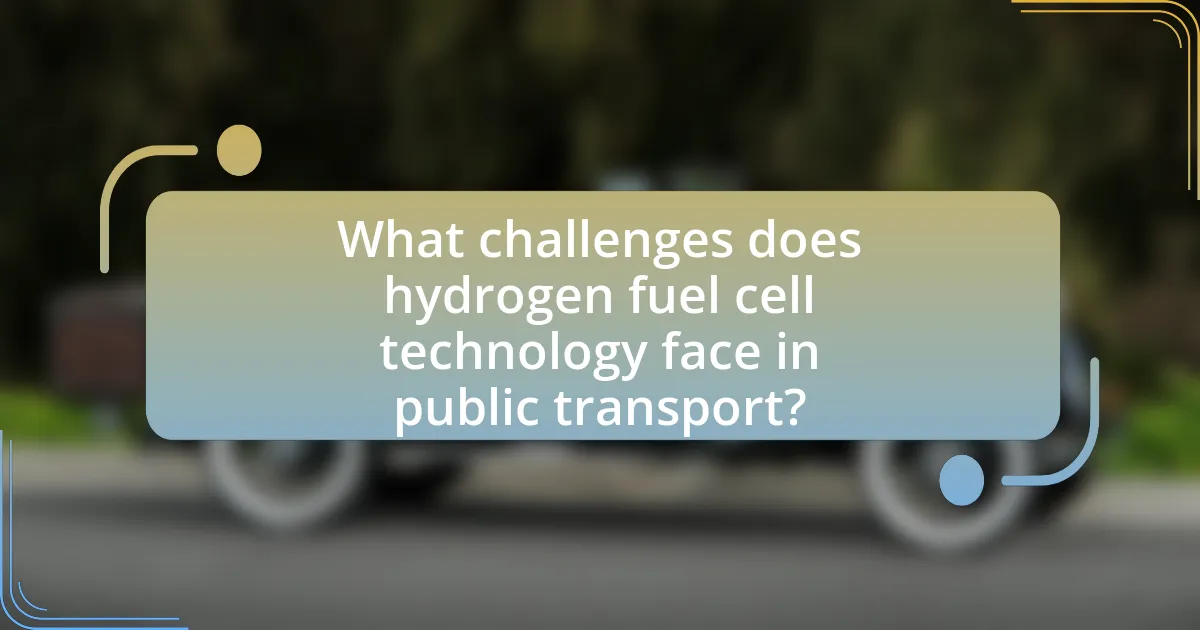
What challenges does hydrogen fuel cell technology face in public transport?
Hydrogen fuel cell technology faces several challenges in public transport, primarily related to infrastructure, cost, and efficiency. The lack of a widespread refueling infrastructure limits the adoption of hydrogen fuel cell vehicles, as operators require accessible refueling stations to ensure operational reliability. Additionally, the high production costs of hydrogen fuel cells, which can exceed $50 per kilowatt, hinder economic viability compared to battery electric vehicles. Furthermore, the energy efficiency of hydrogen production, particularly when derived from fossil fuels, raises concerns about overall environmental benefits. These factors collectively impede the integration of hydrogen fuel cell technology into public transport systems.
What are the economic barriers to adopting hydrogen fuel cells in public transport?
The economic barriers to adopting hydrogen fuel cells in public transport include high initial investment costs, limited infrastructure, and ongoing operational expenses. High initial investment costs arise from the price of hydrogen fuel cell technology and the necessary modifications to existing transport systems. Limited infrastructure, such as the scarcity of hydrogen refueling stations, hampers the feasibility of widespread adoption. Ongoing operational expenses, including the cost of hydrogen production and maintenance of fuel cell systems, further complicate financial viability. According to a report by the International Energy Agency, the cost of hydrogen production remains a significant hurdle, with current prices often exceeding those of conventional fuels, thereby impacting the overall economic attractiveness of hydrogen fuel cells in public transport.
How do initial investment costs compare to traditional fuel systems?
Initial investment costs for hydrogen fuel cell systems are generally higher than those for traditional fuel systems. For instance, the cost of hydrogen fuel cell buses can range from $700,000 to $900,000, while diesel buses typically cost between $300,000 and $500,000. This significant difference in upfront costs is primarily due to the advanced technology and materials required for fuel cells, such as platinum catalysts and high-pressure tanks. Additionally, the infrastructure for hydrogen production and distribution adds to the initial investment, making it more expensive compared to the established infrastructure for traditional fuels.
What are the ongoing operational costs associated with hydrogen fuel cells?
Ongoing operational costs associated with hydrogen fuel cells primarily include hydrogen fuel procurement, maintenance, and system efficiency losses. Hydrogen fuel costs can vary significantly, typically ranging from $4 to $16 per kilogram, depending on production methods and market conditions. Maintenance costs are generally estimated at around 2-5% of the initial capital cost annually, which can be substantial given the high upfront investment in fuel cell technology. Additionally, energy losses during the conversion process can lead to further operational inefficiencies, impacting overall cost-effectiveness. These factors collectively contribute to the ongoing financial considerations for deploying hydrogen fuel cells in public transport systems.
What infrastructure is needed to support hydrogen fuel cell public transport?
Hydrogen fuel cell public transport requires a comprehensive infrastructure that includes hydrogen production facilities, storage systems, distribution networks, and refueling stations. Hydrogen production can be achieved through methods such as electrolysis or steam methane reforming, with facilities needing to be strategically located to ensure supply. Storage systems must be capable of safely holding hydrogen at high pressures, while distribution networks are essential for transporting hydrogen from production sites to refueling stations. Refueling stations should be equipped with high-pressure dispensers to facilitate quick refueling of hydrogen fuel cell vehicles, ensuring minimal downtime for public transport operations. The development of this infrastructure is critical for the successful implementation and expansion of hydrogen fuel cell technology in public transport systems.
How can hydrogen refueling stations be integrated into existing transport networks?
Hydrogen refueling stations can be integrated into existing transport networks by strategically locating them along major transport corridors and near existing fuel infrastructure. This integration can be achieved through collaboration with public transport authorities and private sector stakeholders to identify optimal sites that maximize accessibility for hydrogen-powered vehicles. For instance, studies indicate that placing hydrogen stations within a 10-minute drive of bus depots and transit hubs can significantly enhance the feasibility of hydrogen fuel cell buses, as demonstrated in projects like the UK’s Hydrogen Transport Hub, which aims to support the deployment of hydrogen infrastructure alongside public transport systems.
What are the logistical challenges of hydrogen distribution for public transport?
The logistical challenges of hydrogen distribution for public transport include infrastructure development, storage requirements, and transportation logistics. Infrastructure development is critical as hydrogen refueling stations are limited, necessitating significant investment to establish a widespread network. Storage requirements pose challenges due to hydrogen’s low energy density, which demands high-pressure tanks or cryogenic storage solutions, complicating logistics. Transportation logistics are further complicated by the need for specialized vehicles to transport hydrogen safely, as well as regulatory compliance for hazardous materials. These factors collectively hinder the efficient distribution of hydrogen for public transport systems.
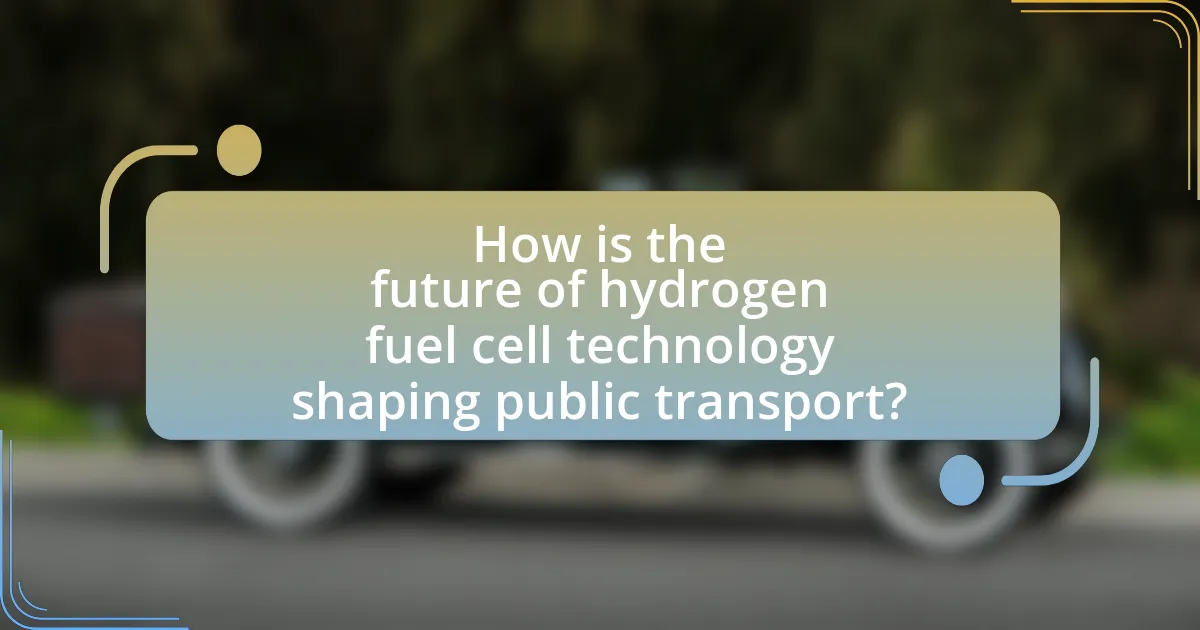
How is the future of hydrogen fuel cell technology shaping public transport?
The future of hydrogen fuel cell technology is significantly shaping public transport by providing a cleaner, more sustainable alternative to traditional fossil fuels. Hydrogen fuel cells produce electricity through a chemical reaction between hydrogen and oxygen, emitting only water vapor as a byproduct, which aligns with global efforts to reduce greenhouse gas emissions. For instance, countries like Germany and Japan are investing heavily in hydrogen infrastructure, with Germany planning to deploy over 1,000 hydrogen-powered buses by 2030. This transition not only enhances air quality but also reduces dependency on oil, promoting energy security. Furthermore, advancements in hydrogen production and storage technologies are making it increasingly feasible for public transport systems to adopt hydrogen fuel cells, thereby improving operational efficiency and reducing long-term costs.
What trends are emerging in hydrogen fuel cell technology for public transport?
Emerging trends in hydrogen fuel cell technology for public transport include increased investment in infrastructure, advancements in fuel cell efficiency, and the integration of hydrogen solutions with renewable energy sources. Investment in hydrogen refueling stations is expanding, with countries like Germany and Japan leading the way, aiming to create a comprehensive network to support fuel cell vehicles. Additionally, recent developments have improved fuel cell efficiency, with some systems achieving over 60% efficiency, enhancing the viability of hydrogen buses and trains. Furthermore, the integration of hydrogen production from renewable sources, such as wind and solar, is gaining traction, promoting a sustainable cycle that reduces carbon emissions in public transport systems.
How are government policies influencing the adoption of hydrogen fuel cells?
Government policies are significantly influencing the adoption of hydrogen fuel cells by providing financial incentives, regulatory frameworks, and research funding. For instance, countries like Germany and Japan have implemented subsidies for hydrogen production and fuel cell vehicles, which lowers the cost barrier for consumers and manufacturers. Additionally, regulatory measures such as emissions targets and clean energy mandates encourage the transition to hydrogen technologies. According to the International Energy Agency, government support has been crucial in increasing the number of hydrogen refueling stations, which is essential for the widespread use of hydrogen fuel cells in public transport.
What role do partnerships between public and private sectors play in advancing this technology?
Partnerships between public and private sectors are crucial in advancing hydrogen fuel cell technology for public transport by facilitating resource sharing, innovation, and infrastructure development. These collaborations enable public entities to leverage private sector expertise and investment, which accelerates research and development efforts. For instance, the collaboration between governments and companies like Toyota and Hyundai has led to significant advancements in fuel cell efficiency and vehicle deployment. Additionally, public-private partnerships can help establish necessary refueling infrastructure, as seen in projects funded by both government grants and private investments, which are essential for the widespread adoption of hydrogen fuel cell vehicles in public transport systems.
What practical steps can cities take to implement hydrogen fuel cell technology in public transport?
Cities can implement hydrogen fuel cell technology in public transport by investing in infrastructure, such as hydrogen refueling stations, and integrating hydrogen-powered vehicles into their fleets. Establishing a network of refueling stations is crucial, as it ensures that hydrogen buses and trains have accessible locations to refuel, similar to traditional fuel stations. For instance, cities like Hamburg have successfully deployed hydrogen refueling infrastructure to support their fleet of hydrogen buses.
Additionally, cities should collaborate with manufacturers to procure hydrogen fuel cell vehicles, which can include buses, trains, and other public transport options. This collaboration can lead to economies of scale, reducing costs and increasing the availability of these vehicles. Furthermore, cities can seek funding and partnerships with governmental and private organizations to support the transition, as seen in initiatives across Europe where public-private partnerships have accelerated the adoption of hydrogen technology in transport.
Lastly, cities can promote public awareness and education about the benefits of hydrogen fuel cells, which can help garner public support and encourage the use of hydrogen-powered transport options. By taking these practical steps, cities can effectively implement hydrogen fuel cell technology in their public transport systems.
What best practices should be followed for successful integration of hydrogen fuel cells?
Successful integration of hydrogen fuel cells requires a comprehensive approach that includes infrastructure development, safety protocols, and stakeholder collaboration. Infrastructure development involves establishing hydrogen production, storage, and distribution systems to ensure accessibility and reliability. Safety protocols must be implemented to address the unique risks associated with hydrogen, including proper handling and emergency response measures. Collaboration among stakeholders, including government agencies, manufacturers, and public transport operators, is essential to align goals, share best practices, and secure funding. These practices are supported by successful case studies, such as the deployment of hydrogen fuel cell buses in cities like Hamburg, which demonstrate the effectiveness of coordinated efforts in enhancing public transport systems.
How can public awareness and education support the transition to hydrogen fuel cells?
Public awareness and education can significantly support the transition to hydrogen fuel cells by increasing understanding and acceptance of this technology among the general population. When individuals are informed about the environmental benefits, such as reduced greenhouse gas emissions and improved air quality, they are more likely to advocate for and adopt hydrogen fuel cell solutions. For instance, a study by the International Energy Agency indicates that public acceptance is crucial for the successful deployment of new energy technologies, including hydrogen fuel cells. Furthermore, educational initiatives can provide insights into the safety and efficiency of hydrogen as a fuel source, addressing common misconceptions and fears. This informed public can drive demand for hydrogen-powered public transport, influencing policymakers to invest in infrastructure and research, thereby accelerating the transition to hydrogen fuel cells.
